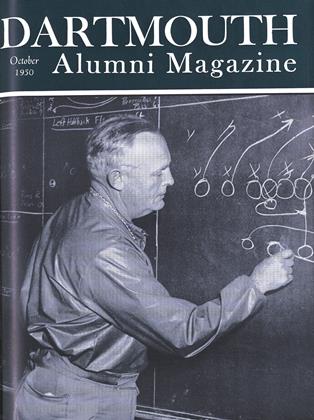by John Varney 'op.The William-Frederick, Press, 313 West 35thSt., New York 1950; pages 47; $l.OO.
In the five parts and fifty numbered sections of this poem, the writing of which extended from November of 1948 to May of this year, Varney has struck out a new style in the writing of satiric-critical poetry. The verse is compact, elliptical in phrasing, and, until one gets the hang of it, almost spondaic, the lines seem to move so slowly with their freight of long syllables. The content, too, does not make for easy reading; there are certain recurring symbols which are—some of themelusive in meaning; and the verse is packed with allusions to circumstances in the career of the writers (mostly modern poets) whom it criticises. But the perservering reader will be rewarded by many bits of shrewd observation and flashes of idiosyncratic humor, and will perceive in these lines the alert and instructive mind of their author.
Varney passes in review certain major figures T. S. Eliot, E. E. Cummings, Wallace Stevens with incidental references to others from Yeats and Rimbaud to the present. Against a background of modern philosophy, science, and art, he poses his main figures as exemplars of an inbreeding, too highly self conscious, and essentially decadent though peacockishly seductive art. Yet the characteristics of these writers are only in part selfwilled; they are characteristics of our civilization, of which they are spokesmen. Varney looks forward to a future in which, by means not too clearly defined, art will become at once simpler and more varied, and a center of affirmation and unity for the whole community of mankind, instead of being, as it is now, both product and promoter of a lack of imaginative fellowship between the "levels" into which men have become stratified.
 View Full Issue
View Full Issue
More From This Issue
-
 Sports
SportsFINIS
October 1950 By Bernard G. Sykes '51 -
 Article
ArticleMan on the Job . . . for Thirty Years
October 1950 By JOHN HURD '21 -
 Class Notes
Class Notes1918
October 1950 By ERNEST H. EARLEY, DONALD L. BARR, DAVID L. GARRATT -
 Class Notes
Class Notes1923
October 1950 By TRUMAN T. METZEL, COLIN C. STEWART 3RD, JULIUS A. RIPPEL -
 Class Notes
Class Notes1905
October 1950 By GEORGE W. PUTNAM, GILBERT H. FALL -
 Article
ArticleTHERE'S METHOD Behind the Fall Madness
October 1950 By ROGER K. WOLBARST '43
F. Cudworth Flint
-
 Books
BooksSADDLING PEGASUS
JANUARY 1932 By F. Cudworth Flint -
 Books
BooksBEAU-POIL AU MAROC
June 1940 By F. Cudworth Flint -
 Books
BooksAN HERB BASKET,
March 1951 By F. CUDWORTH FLINT -
 Books
BooksTHE MODERN CRITICAL SPECTRUM.
DECEMBER 1962 By F. CUDWORTH FLINT -
 Books
BooksTHE WORLD, THE WORLDLESS.
JUNE 1965 By F. CUDWORTH FLINT -
 Books
BooksTHE GEORGIAN REVOLT: RISE AND FALL OF A POETIC IDEAL, 1910-1922.
NOVEMBER 1965 By F. CUDWORTH FLINT
Books
-
 Books
BooksTHE CASE FOR EXPERIENCE RATING IN UNEMPLOYMENT COMPENSATION AND A PROPOSED METHOD
May 1939 -
 Books
BooksFrontier Plans and Dreams
May 1980 By James Wright -
 Books
BooksBut No B-52's
October 1975 By JOHNHURD '21 -
 Books
BooksTHE CLAMBAKE MUTINY.
JUNE 1965 By R.J.B. -
 Books
BooksHELIX,
October 1947 By Sidney Cox -
 Books
BooksARROWS OF LIGHT
May 1935 By William H. Wood

